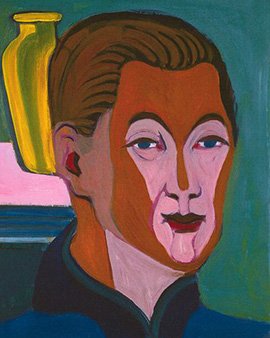The great painters of Impressionism paved the way for Modernist painting. A major change in society and painting was the turn to Expressionism. To place the inner expression of the artist above nature was the logical continuation of the social change. Ernst Ludwig Kirchner dealt with the increasing industrialisation in an artistic way. Munch had caused an impetus with his works, which spread in the German art scene. Kirchner devoted himself to expressive painting. To use color as a medium to give the artist's feelings a language. Formation has a low priority, the figures appear partly rough. Kirchner chose an often angular body shape, which is partly due to the rapid brushwork, but is also a characteristic feature of the artist.
The painters of Expressionism are criticized at the beginning of the epoch. Lack of talent and disregard for artistic conventions are among the points of criticism. When further development comes to a halt due to a lack of training opportunities, some followers of the group of artists form the bridge. Ernst Ludwig Kirchner is one of the founding members who see their task in the development of new ways of expression in art. Painters such as Nolde and Pechstein belonged to the association. In an autodidactic way the painters developed the possibility of using the canvas as a mirror of their emotions.
The work of Ernst Ludwig Kirchner shows two sides of his person. Kirchner has captured the life of the streets of Berlin. He recorded the spectacle in the variety theater and in the inns and captured the hectic and often gray everyday life of the big city. For inner peace, the artist was drawn to Davos. Here he created colourful works with an expressive visual language. At this time Kirchner suffered from depression and art historians discover the phases of illness in his work. When the National Socialist regime took power in Germany, Kirchner's art was declared degenerate. Many of the painter's works were destroyed. For an artist who has portrayed his deep emotions and shares an attachment to his works, the extent of the injury is unimaginable. For Kirchner the losses led to suicide and he took his own life in 1938.
×





.jpg)
.jpg)
_1929_-_(MeisterDrucke-803243).jpg)
_1929_-_(MeisterDrucke-803243).jpg)
.jpg)
.jpg)
.jpg)
.jpg)
.jpg)
.jpg)
.jpg)
.jpg)
.jpg)
.jpg)
.jpg)
.jpg)
.jpg)
.jpg)
.jpg)
.jpg)
.jpg)
.jpg)
.jpg)
.jpg)
.jpg)
.jpg)
.jpg)
.jpg)
.jpg)
.jpg)
.jpg)
.jpg)
.jpg)
.jpg)
.jpg)
.jpg)
.jpg)
.jpg)
.jpg)
.jpg)
.jpg)
.jpg)
.jpg)
.jpg)
.jpg)
.jpg)
.jpg)
.jpg)
.jpg)
.jpg)
.jpg)
.jpg)
.jpg)
.jpg)
.jpg)
.jpg)
.jpg)
.jpg)
.jpg)
.jpg)
.jpg)
.jpg)
.jpg)
.jpg)
.jpg)
.jpg)
.jpg)
.jpg)
.jpg)
.jpg)
.jpg)
.jpg)
 Playing Chess 1913 - (MeisterDrucke-264162).jpg)
 Playing Chess 1913 - (MeisterDrucke-264162).jpg)
.jpg)
.jpg)
.jpg)
.jpg)
.jpg)
.jpg)
.jpg)
.jpg)
.jpg)
.jpg)
.jpg)
.jpg)
_-_191_-_(MeisterDrucke-1031380).jpg)
_-_191_-_(MeisterDrucke-1031380).jpg)
.jpg)
.jpg)
.jpg)
.jpg)
.jpg)
.jpg)
.jpg)
.jpg)
.jpg)
.jpg)
.jpg)
.jpg)
 - (MeisterDrucke-56533).jpg)
 - (MeisterDrucke-56533).jpg)
.jpg)
.jpg)
.jpg)
.jpg)
.jpg)
.jpg)
.jpg)
.jpg)
.jpg)
.jpg)
.jpg)
.jpg)
.jpg)
.jpg)
.jpg)
.jpg)
.jpg)
.jpg)
.jpg)
.jpg)
.jpg)
.jpg)
_-_(MeisterDrucke-692409).jpg)
_-_(MeisterDrucke-692409).jpg)
_-_(MeisterDrucke-694877).jpg)
_-_(MeisterDrucke-694877).jpg)
.jpg)
.jpg)
.jpg)
.jpg)
.jpg)
.jpg)
.jpg)
.jpg)
.jpg)
.jpg)
.jpg)
.jpg)
.jpg)
.jpg)
.jpg)
.jpg)
.jpg)
.jpg)
.jpg)
.jpg)
.jpg)
.jpg)
.jpg)
.jpg)
.jpg)
.jpg)
.jpg)
.jpg)
_-_(MeisterDrucke-689047).jpg)
_-_(MeisterDrucke-689047).jpg)
.jpg)
.jpg)
.jpg)
.jpg)
.jpg)
.jpg)
_-_(MeisterDrucke-693581).jpg)
_-_(MeisterDrucke-693581).jpg)
.jpg)
.jpg)
.jpg)
.jpg)
.jpg)
.jpg)
.jpg)
.jpg)
.jpg)
.jpg)
.jpg)
.jpg)
.jpg)
.jpg)
.jpg)
.jpg)
.jpg)
.jpg)
.jpg)
.jpg)
_-_(MeisterDrucke-692017).jpg)
_-_(MeisterDrucke-692017).jpg)
.jpg)
.jpg)
.jpg)
.jpg)
.jpg)
.jpg)
.jpg)
.jpg)
.jpg)
.jpg)
.jpg)
.jpg)






